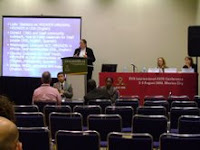
On Thursday afternoon we gave a Skills Building Workshop. Although our attendance wasn't large, the audience was very international with people from Africa, Asia and North America, and were very interested in what we had to say. As I hoped, we made a number of new and useful connections. A summary of what people were speaking about and notes on the presentation I gave are below.
Reaching Deaf Communities
A Workshop on Bridging the Gaps
AIDS 2008, Mexico City
August 7, 2008
Presenters
Leila Monaghan, University of Wyoming, USA
Donald Pilling, CSSQ, Canada
Washington Opiyo Sati, Liverpool VCT, Kenya
Claudia Bisol, Universidade Federal do Rio Grande do Sul, Brazil
Jessica de Ruijter, VSO, Netherlands
Leila Monaghan
Anthropologist
Overview of issues
Presentation of demographic information
Introduction of some of the solutions
Donald Pilling
President, Coalition SIDA des Sourds du Quebec
Long time AIDS activist
Part of only Deaf run AIDS organization in the world
Years of experience doing outreach to Canadian Deaf communities
Has examples of outreach materials
Washington Opiyo Sati
Director, Deaf Outreach, Liverpool VCT, Kenya
Organizes regular stationary and mobile counseling and testing units (MVCT)
Made Kenya a model for many other countries
Claudia Bisol
Psychologist
Teaches at University of Caxias do Sul, Brazil
Coordinator of program for Deaf students
Research about Deaf adolescents and sexuality including narratives about sex
Jessica de Ruijter
Advocacy Officer, Voluntary Service Organization (VS0), Netherlands
Before starting at VSO in October, worked on prevention at UNFPA in China and for Dutch Ministry of Foreign Affairs
Will speak about challenges VSO has in doing work supporting programs for HIV & AIDS and disabilities.
Leila Monaghan
HIV/AIDS and Deaf PeopleDeaf people are often cut off from mainstream communication methods
Can’t get information from television, radio
Often also have trouble with complex literacy
Natural language for most Deaf people is sign language
Deaf people often part of close knit communities
Sexually active but don’t have information about protection
Governments often ignore needs of Deaf people
US ExampleCDC does not keep statistics
Only state of Maryland does
Results from public testing data since 2003 show Deaf people are twice as likely to be HIV+ as hearing people.
In African American population of MD, hearing rate 3.4%, Deaf rate 6.4%
Epidemic is different in Deaf community, almost 1:1 male to female.
Differences between Deaf and hearing get worse as people getting tested get younger.
Many attempts to help Deaf community are cosmetic
TTY phone numbers listed don’t work
http://hivtest.org provides ASL as language but not searchable
Small centers often served community but support has dwindled in last 8 years
Can contact Leila at:
Hivdeaf at gmail dot com


